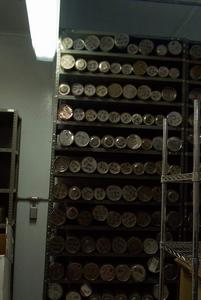7 August, 2002
Greetings Statement
Today (6 August, 2002 – I am posting this a day late) is my first field
experience and journal entry as a TEA team member. Our “destination” is a
guided tour of the CRREL building in Hanover, New Hampshire.
Current Conditions
It is cool, breezy, pleasant, in the low 70s and slightly overcast. A long
spell of muggy weather has been interrupted by gusts of chill. I am told
that a cold front is pushing Arctic air across Canada and down into the
northeastern US. The cool wind reminds me of my pending Arctic journey.
Where Are We Now?
CRREL
The temperature was –20 F., and the air smelled like cold steel. I could
feel my denim jeans begin to stiffen as the coldness seeped through my
clothes. It was so dry that I could not see anyone’s exhaled breath, but I
could feel all the moisture being pulled from my pores. Where was I?
In Hanover, New Hampshire, at the Cold Regions Research and Engineering Lab.
I am here with 11 other TEA teachers as part of our orientation and
preparation for our Arctic and Antarctic trips. Our tour guide is Marie
Darling, the Public Affairs Specialist for this site
CRREL is the US Army Corps of Engineers Engineering and Development Center
for Cold Weather Research. Other Corps sites include Topographical
Engineering, Environmental, Information Technology, Coastal and Hydraulics,
and Geotechnical Centers located around the country.
There are approximately 300 scientists and workers at CRREL who are involved
in basic and applied research focusing specifically on polar climates.
Projects vary from finding and cleaning polar contamination to studying the
behavior of materials under extreme weather field conditions. “Support for
the soldier in the field, research, and civil works is the focus of CRREL,”
according to Ms. Darling. In addition to maintaining a comprehensive
research library and database sets, CRREL has an extensive website that
includes reports and fact sheets that may be accessed and downloaded
Scientists at Work – What’s Going On At CRREL?
Just walking down the hallways was fascinating. Informational posters about
everything from polar aviation to ice chemistry, GIS, snowmelt modeling, and
stratigraphy, for example, lined the walls. Each topic captured my
attention, and I wanted to say, “I want to work on this project!” at each
stop. Here is the most compelling of them:
The Cold Room
Our first stop was in a “cold room” – a storage facility for ice core
samples. My preconceived ideas of “cold” quickly vanished upon entering this
room
The ice core samples were stored in long metal tubes arranged in
floor-to-ceiling racks. Each tube was marked to indicate the collecting
depth (in meters) and the origin of the sample.
As we left the cold room, the previously chilly hallway now seemed very
warm.
The South Pole Tunneling System
Utility corridors must be constructed under the snow pack. Temperatures of
–120 to –124 F. at the snow surface combined with fierce wind makes it
impossible to house sensitive scientific equipment directly on the surface
of the snow. The unique tunneling system developed at CRREL allows engineers
to build sub-surface utility corridors in adverse conditions.
Ms. Darling described the South Pole Tunneling System as a “bobcat
excavator” system. A bobcat bulldozer equipped with a special device chips
away at hard pack snow. This chipper device digs at an angle until it
reaches a vertical depth of 42 feet, and then proceeds to chip out a tunnel
400 feet long. The chipped snow, which is very dry, is then pulled back out
of the tunnel by the wind suction and is blown away. No muss, no fuss. It
seems to be a very efficient system.
Environmental Aspects – Eagle River Flats Project
The environmental division of CRREL focuses on three main areas: 1)
protection and remediation of contamination sites, 2) vegetation research
and application in training lands, and 3) bio-remediation. Chemists are
actively involved in finding better ways to clean up oil spills and other
forms of pollution in sensitive polar environments. Other scientists are
investigating species of plants that are resistant to trampling by troops
and equipment during training exercises and that will re-grow quickly after
artillery damage. Bio-remediation research projects often involve
investigating plants that may be used to neutralize contaminants such as oil
and industrial toxins.
The Eagle River Flats Project was of parcticular interest to me. Eagle River
Flats is a saltwater marsh area that was used as a munitions ground. White
phosphorus, a munitions explosion by-product, settled in the marsh and was
ingested by native ducks. The phosphorus caused paralysis, and the ducks
would drown. When hunters began to become alarmed, an investigation was
launched, and the white phosphorus residue was identified as the cause of
paralysis and subsequent duck deaths. CRREL researchers decided to divide
the marsh into sections and let one section at a time dry out. Once exposed
to the air, the white phosphorus vaporized. This is a 5-phase project, and
three of the phases have been completed. As a result of the Eagle River
Flats Project and remediation, the firing of white phosphorus munitions has
been halted.
Questions for later: 1) What exactly is white phosphorus, and why is it used
in munitions? 2) How does white phosphorus trigger paralysis in ducks, and
what is the nature of the paralysis?
Our tour of CRREL gave me a more clear understanding of the variety and
scope of the projects carried out at this facility. I now have a greater
appreciation of the amount of work that goes into the support of polar
research and programs.
_________________________________________________________________
Send and receive Hotmail on your mobile device: http://mobile.msn.com

The Cold Room
Contact the TEA in the field at
.
If you cannot connect through your browser, copy the
TEA's e-mail address in the "To:" line of
your favorite e-mail package.
|
